Hãy nhập câu hỏi của bạn vào đây, nếu là tài khoản VIP, bạn sẽ được ưu tiên trả lời.

Ta có: \(f'\left(x\right)=x^2-2x-3\)
\(f'\left(x\right)\le0\\ \Rightarrow x^2-2x-3\le0\\ \Leftrightarrow\left(x+1\right)\left(x-3\right)\le0\\ \Leftrightarrow-1\le x\le3\)

3.
Đặt \(f\left(x\right)=x^4-3x^3+x-\dfrac{1}{8}\)
Hàm \(f\left(x\right)\) liên tục trên R
Do \(f\left(x\right)\) là đa thức bậc 4 nên có tối đa 4 nghiệm
Ta có: \(f\left(-1\right)=\dfrac{23}{8}>0\)
\(f\left(0\right)=-\dfrac{1}{8}< 0\Rightarrow f\left(-1\right).f\left(0\right)< 0\)
\(\Rightarrow f\left(x\right)\) luôn có ít nhất 1 nghiệm thuộc \(\left(-1;0\right)\)
\(f\left(\dfrac{1}{2}\right)=\dfrac{1}{16}>0\Rightarrow f\left(0\right).f\left(\dfrac{1}{2}\right)< 0\)
\(\Rightarrow f\left(x\right)\) luôn có ít nhất 1 nghiệm thuộc \(\left(0;\dfrac{1}{2}\right)\)
\(f\left(1\right)=-\dfrac{9}{8}< 0\Rightarrow f\left(\dfrac{1}{2}\right).f\left(1\right)< 0\)
\(\Rightarrow f\left(x\right)\) luôn có ít nhất 1 nghiệm thuộc \(\left(\dfrac{1}{2};1\right)\)
\(f\left(3\right)=\dfrac{23}{8}>0\Rightarrow f\left(1\right).f\left(3\right)< 0\)
\(\Rightarrow f\left(x\right)\) luôn có ít nhất 1 nghiệm thuộc \(\left(1;3\right)\)
Vậy pt có 4 nghiệm thuộc các khoảng nói trên
4.
\(\lim\limits_{x\rightarrow-\infty}\left(\sqrt{x^2+ax+2017}+x\right)=\lim\limits_{x\rightarrow-\infty}\dfrac{ax+2017}{\sqrt{x^2+ax+2017}-x}\)
\(=\lim\limits_{x\rightarrow-\infty}\dfrac{a+\dfrac{2017}{x}}{-\sqrt{1+\dfrac{a}{x}+\dfrac{2017}{x^2}}-1}=-\dfrac{a}{2}\)
\(\Rightarrow-\dfrac{a}{2}=6\Rightarrow a=-12\)

1.
\(cos2x-3cosx+2=0\)
\(\Leftrightarrow2cos^2x-3cosx+1=0\)
\(\Leftrightarrow\left[{}\begin{matrix}cosx=1\\cosx=\dfrac{1}{2}\end{matrix}\right.\)
\(\Leftrightarrow\left[{}\begin{matrix}x=k2\pi\\x=\pm\dfrac{\pi}{3}+k2\pi\end{matrix}\right.\)
\(x=k2\pi\in\left[\dfrac{\pi}{4};\dfrac{7\pi}{4}\right]\Rightarrow\) không có nghiệm x thuộc đoạn
\(x=\pm\dfrac{\pi}{3}+k2\pi\in\left[\dfrac{\pi}{4};\dfrac{7\pi}{4}\right]\Rightarrow x_1=\dfrac{\pi}{3};x_2=\dfrac{5\pi}{3}\)
\(\Rightarrow P=x_1.x_2=\dfrac{5\pi^2}{9}\)
2.
\(pt\Leftrightarrow\left(cos3x-m+2\right)\left(2cos3x-1\right)=0\)
\(\Leftrightarrow\left[{}\begin{matrix}cos3x=\dfrac{1}{2}\left(1\right)\\cos3x=m-2\left(2\right)\end{matrix}\right.\)
\(\left(1\right)\Leftrightarrow x=\pm\dfrac{\pi}{9}+\dfrac{k2\pi}{3}\)
Ta có: \(x=\pm\dfrac{\pi}{9}+\dfrac{k2\pi}{3}\in\left(-\dfrac{\pi}{6};\dfrac{\pi}{3}\right)\Rightarrow x=\pm\dfrac{\pi}{9}\)
Yêu cầu bài toán thỏa mãn khi \(\left(2\right)\) có nghiệm duy nhất thuộc \(\left(-\dfrac{\pi}{6};\dfrac{\pi}{3}\right)\)
\(\Leftrightarrow\left[{}\begin{matrix}m-2=0\\m-2=1\\m-2=-1\end{matrix}\right.\Leftrightarrow\left[{}\begin{matrix}m=2\\m=3\\m=1\end{matrix}\right.\)
TH1: \(m=2\)
\(\left(2\right)\Leftrightarrow cos3x=0\Leftrightarrow x=\dfrac{\pi}{6}+\dfrac{k2\pi}{3}\in\left(-\dfrac{\pi}{6};\dfrac{\pi}{3}\right)\Rightarrow x=\dfrac{\pi}{6}\left(tm\right)\)
\(\Rightarrow m=2\) thỏa mãn yêu cầu bài toán
TH2: \(m=3\)
\(\left(2\right)\Leftrightarrow cos3x=0\Leftrightarrow x=\dfrac{k2\pi}{3}\in\left(-\dfrac{\pi}{6};\dfrac{\pi}{3}\right)\Rightarrow x=0\left(tm\right)\)
\(\Rightarrow m=3\) thỏa mãn yêu cầu bài toán
TH3: \(m=1\)
\(\left(2\right)\Leftrightarrow cos3x=-1\Leftrightarrow x=\dfrac{\pi}{3}+\dfrac{k2\pi}{3}\in\left(-\dfrac{\pi}{6};\dfrac{\pi}{3}\right)\Rightarrow\left[{}\begin{matrix}x=\pm\dfrac{1}{3}\\x=-1\\x=-\dfrac{5}{3}\end{matrix}\right.\)
\(\Rightarrow m=2\) không thỏa mãn yêu cầu bài toán
Vậy \(m=2;m=3\)

1.
Đặt \(f\left(x\right)=\left(m^2+1\right)x^3-2m^2x^2-4x+m^2+1\)
\(f\left(x\right)\) xác định và liên tục trên R
\(f\left(x\right)\) có bậc 3 nên có tối đa 3 nghiệm (1)
\(f\left(0\right)=m^2+1>0\) ; \(\forall m\)
\(f\left(1\right)=\left(m^2+1\right)-2m^2-4+m^2+1=-2< 0\) ;\(\forall m\)
\(\Rightarrow f\left(0\right).f\left(1\right)< 0\Rightarrow f\left(x\right)\) luôn có ít nhất 1 nghiệm thuộc \(\left(0;1\right)\) (2)
\(f\left(2\right)=8\left(m^2+1\right)-8m^2-8+m^2+1=m^2+1>0\)
\(\Rightarrow f\left(1\right).f\left(2\right)< 0\Rightarrow f\left(x\right)\) luôn có ít nhất 1 nghiệm thuộc \(\left(1;2\right)\) (3)
\(f\left(-3\right)==-27\left(m^2+1\right)-18m^2+12+m^2+1=-44m^2-14< 0\)
\(\Rightarrow f\left(-3\right).f\left(0\right)< 0\Rightarrow f\left(x\right)\) luôn có ít nhất 1 nghiệm thuộc \(\left(-3;0\right)\) (4)
Từ (1); (2); (3); (4) \(\Rightarrow f\left(x\right)=0\) có đúng 3 nghiệm phân biệt
2.
Đặt \(t=g\left(x\right)=x.cosx\)
\(g\left(x\right)\) liên tục trên R và có miền giá trị bằng R \(\Rightarrow t\in\left(-\infty;+\infty\right)\)
\(f\left(t\right)=t^3+m\left(t-1\right)\left(t+2\right)\)
Hàm \(f\left(t\right)\) xác định và liên tục trên R
\(f\left(1\right)=1>0\)
\(f\left(-2\right)=-8< 0\)
\(\Rightarrow f\left(1\right).f\left(-2\right)< 0\Rightarrow f\left(t\right)=0\) luôn có ít nhất 1 nghiệm thuộc \(\left(-2;1\right)\)
\(\Rightarrow f\left(x\right)=0\) luôn có nghiệm với mọi m
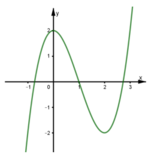




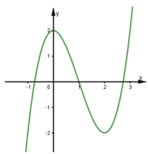

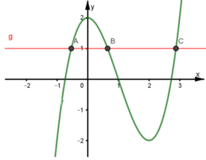
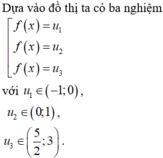

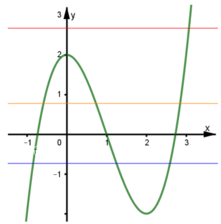

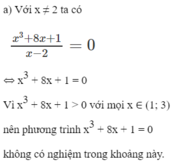
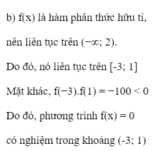
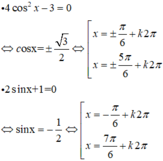

Đáp án D
Xét hàm số f ( x ) = x 4 - 3 x 3 + x + 1 8 = 0 liên tục trên [-1;3] .
Ta có : f ( - 1 ) = 23 8 ; f ( 0 ) = - 1 8 ; f 1 2 = 1 16 ; f ( 1 ) = - 9 8 ; f ( 3 ) = 23 8 .Suy ra :
f ( - 1 ) . f ( 0 ) < 0 ; f ( 0 ) . f 1 2 < 0 ;
f 1 2 . f 1 < 0 và f 1 . f 3 > 0
Do đó phương trình có ít nhất 4 ngiệm thuộc khoảng (-1;3).
Mặt khác phương trình bậc 4 có tối đa bốn nghiệm.
Vậy phương trình có đúng 4 nghiệm thuộc khoảng (-1;3).